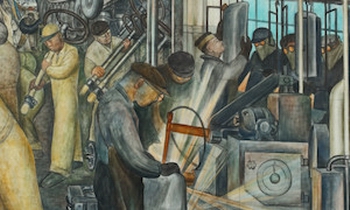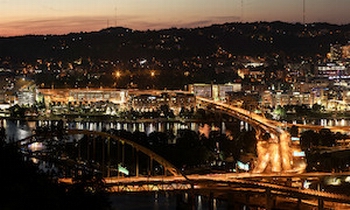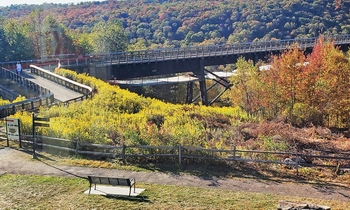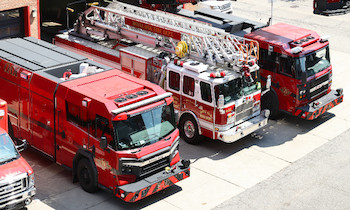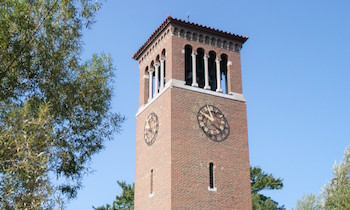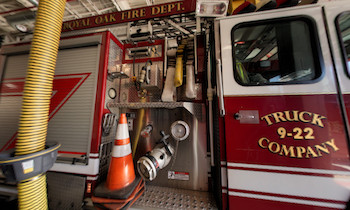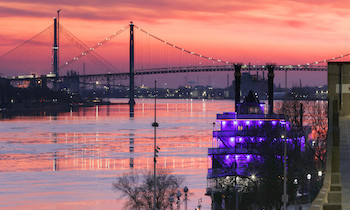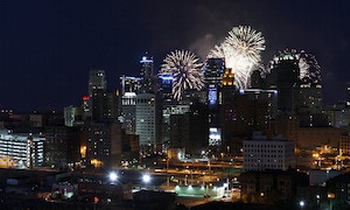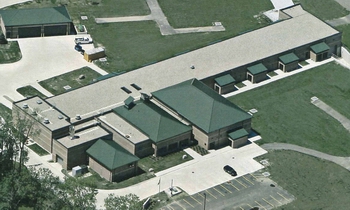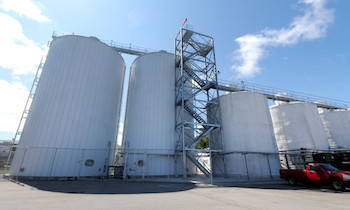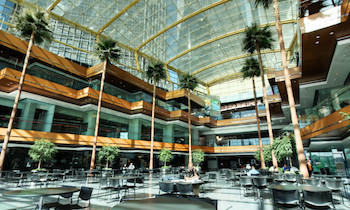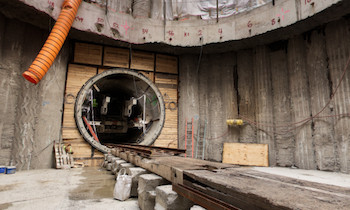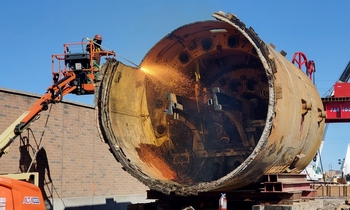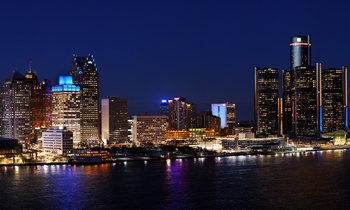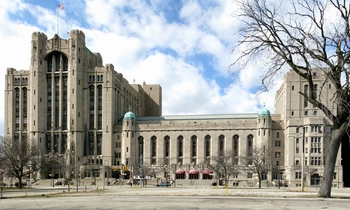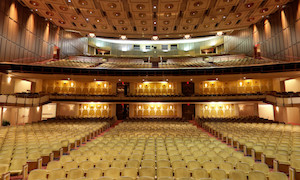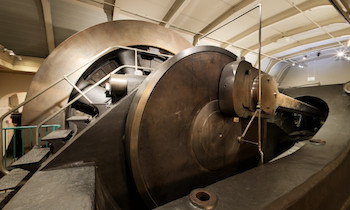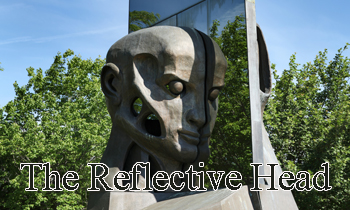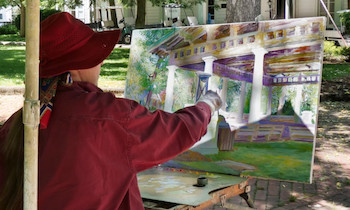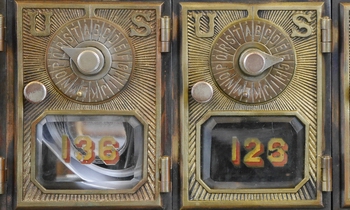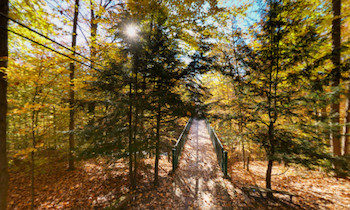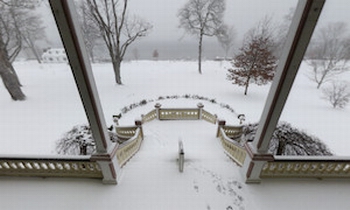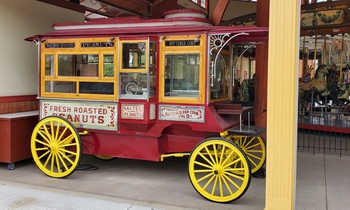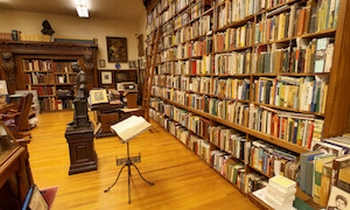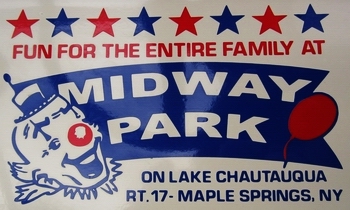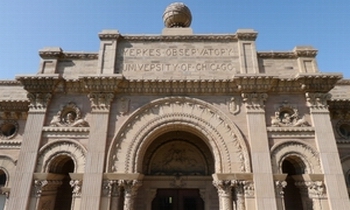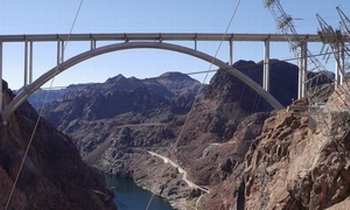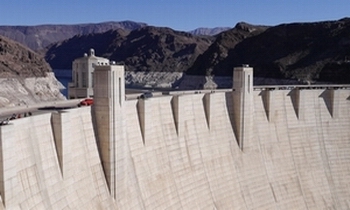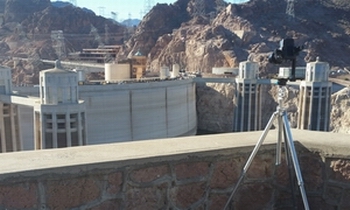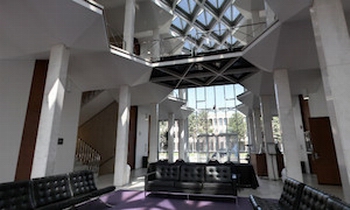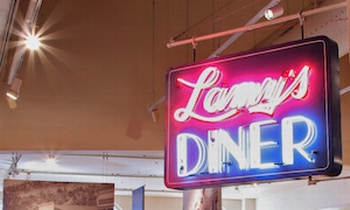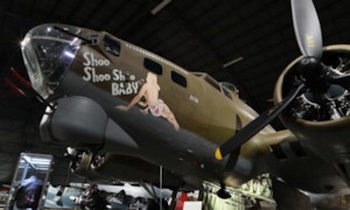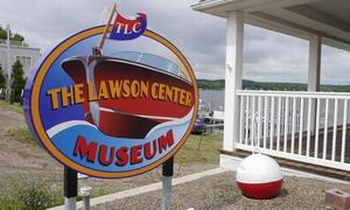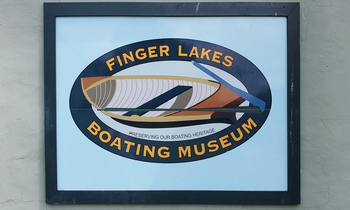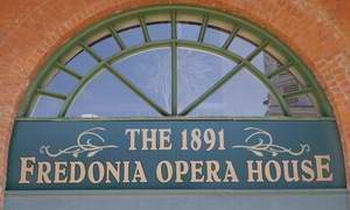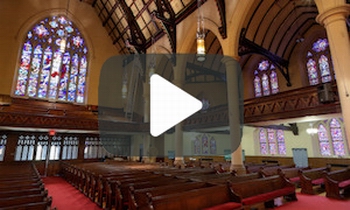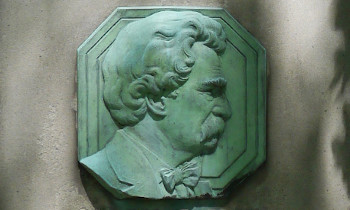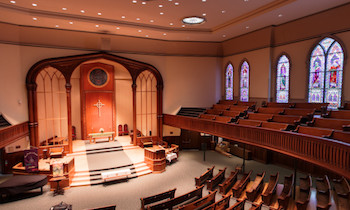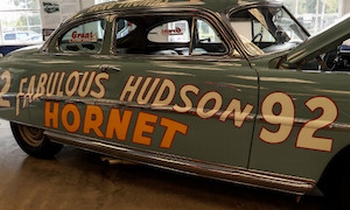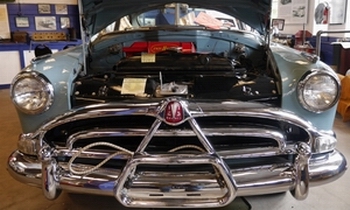|
|
Detroit Industry Murals, Detroit Institute of Arts
The Detroit Industry Murals (Rivera Court, Detroit Institute of Arts) were created between 1932
and 1933. The large panels on the north and south walls depict Rivera's artistic conception of the Ford Rouge plant. Rivera incorported the varied scenes of late-1920s industrial Detroit into a realistic, yet abstract creation of monumental scale and detail, and all within the confines of an existing space, the DIA's 1932 Garden Court. If you are interested in
learning more about these frescoes, the book, Diego Rivera: The Detroit Industry Murals, by Linda Bank Downs, is an excellent reference. There are 3 panoramas in this mini tour. Be sure
to zoom in and out looking at details as you appreciate Diego Rivera's work. Note: the 2nd panorama in this tour was one of 3 chosen to be included in an exhibition at the Whitney Museum of American Art. The 3rd panorama was chosen as an Editor's Pick on the international panorama site, 360cities.net.
|
|
|
Detroit Industry Murals, Detroit Institute of Arts
The Detroit Industry Murals (Rivera Court, Detroit Institute of Arts) were created between 1932
and 1933. The large panels on the north and south walls depict Rivera's artistic conception of the Ford Rouge plant. Rivera incorported the varied scenes of late-1920s industrial Detroit into a realistic, yet abstract creation of monumental scale and detail, and all within the confines of an existing space, the DIA's 1932 Garden Court. If you are interested in
learning more about these frescoes, the book, Diego Rivera: The Detroit Industry Murals, by Linda Bank Downs, is an excellent reference. Take a look at this 1.48 gigapixel spherical
panorama! Be sure to zoom way in and out looking at details as you appreciate Diego Rivera's work.
|
|
|
Detroit Industry Murals, Detroit Institute of Arts
The Detroit Industry Murals (Rivera Court, Detroit Institute of Arts) were created between 1932
and 1933. The large panels on the north and south walls depict Rivera's artistic conception of the Ford Rouge plant. Rivera incorported the varied scenes of late-1920s industrial Detroit into a realistic, yet abstract creation of monumental scale and detail, and all within the confines of an existing space, the DIA's 1932 Garden Court. If you are interested in
learning more about these frescoes, the book, Diego Rivera: The Detroit Industry Murals, by Linda Bank Downs, is an excellent reference. This 1.48 gigapixel panorama will autoplay, then
repeat after 2.5 minutes (no mouse or finger gesture needed).
|
|
|
Charles Lindbergh's Camping Trailer, Dearborn, MI
This two-panorama mini-tour features Charles Lindbergh's camping trailer--a trailer that was presented to Lindbergh by Henry Ford, who admired Lindbergh for his courage, stamina, and knowledge, but also for his political and social views. Lindbergh's 3000-mile solo flight from New York to Paris in 1927 not only made him internationally famous, but also advanced the development of air travel, which happened to be one of Ford's interests. Years after Lindbergh's death, details of his personal life emerged, tarnishing the image of this real-life 20th-century superhero, when it was discovered that Lindbergh had fathered 6 kids in Germany with 3 women--3 kids with Brigitte Hesshaimer, 2 with Mariette Hesshaimer (Brigitte's sister!), and 2 with Valeska LNU (Lindbergh was in his late 50s and early 60s at the time). When you add the 6 kids he had with his wife, Anne Morrow, that makes a grand total of 13. One more interesting fact: Lindbergh disguised himself as Careu Kent, which seems a bit revealing since the alias hints at another famous superhero, but one who worked for the Daily Planet and didn't need an airplane to fly.
|
|
|
Liberty Aviation Museum, Port Clinton, OH
The Liberty Aviation Museum opened in 2012 at the Erie-Ottawa International Airport, Port Clinton, Ohio. In 1991, after an interested museum group was formed, the Liberty Aviation Museum was officially created. Its first acqusition was a 1929 Ford Tri-Motor airliner, now named the City of Port Clinton/City of Wichita, with historic connections to the Port Clinton community and airport. Next came the acquisition of a World War II B25, followed by all sorts of vehicles, planes, boats, and so on, including a 72-foot Vosper PT boat. This 16-panorama tour will begin with an interactive menu that will take you to 5 different sets of panoramas. DetroitDave wishes to thank Doug and Mike for their cooperation with this project.
|
|
|
Detroit Skyline from Windsor, Ontario
The 21-story roof of 75 Riverside East is the ideal spot to photograph the skyline of Detroit. This panoramic tour will begin with one spherical panorama (look up and behind you to find the DeetroitDave hotspot on top of 75 Riverside East), followed by three 180 degree panoramas, the 3rd of which is 5.2 gigapixels. DeetroitDave wishes to thank Blake for his interest and help with this project. For those of you who are familiar with the Detroit Area, here's a challenge while viewing the gigapixel panorama: find the Boblo boat (beyond the Belle Isle Bridge) and the steeple of the Henry Ford Museum (Detroit side of the Ambassador Bridge, beyond the stacks of Ford Rouge Truck Plant).
|
|
|
Pittsburgh from Mt. Washington
Mt. Washington rises approximately 400 feet above the south side of the Monongahela River. The
hilltop community was developed in the early 1800s by and for German immigrants who worked in many of Pittsburgh's mills. The Duquesne (1877) and Monongahela (1870) Inclines were built to transport the workers up and down the mountain, and are still in use. Take a look at two spectacular gigapixel panoramas of the Pittsburgh skyline at dusk and during the day. Be sure to zoom in and out.
|
|
|
Kinzua Bridge State Park, PA
The Kinzua Viaduct was one of the longest and highest railroad bridges anywhere (301 ft. above the valley, 2053 ft. long) until 2003 when it was partially destroyed by a tornado. The acreage surrounding the bridge was purchased in 1963 by the State of Pennsylvania after a failed attempt to reclaim the bridge as scrap. In 2011, the remaining bridge structure (600 ft.) was restored as a pedestrian walkway and observation platform. In 2016, a superb visitor center/museum was built to display artifacts of historical interest. This tour is will feature two panoramas, a spherical, followed by a high-resolution flat panorama.
|
|
|
Fire Station No. 1, Royal Oak, MI
The Royal Oak Fire Department asked DeetroitDave to create two mini murals featuring the trucks at Station No. 1, including the spectacular Rosenbauer King Cobra ladder truck. In order to create very high resolution files that show exceptional detail in a small mural, DeetroitDave chose to shoot multiple-shot panoramas using a short telephoto lens (70 mm). This
technique requires 3 rows of 8 pictures, each taken at 15-degree horizontal increments and 18-degree vertical increments. The files used for printing were cropped versions of the 2 panoramas
shown in this mini tour. The panoramas presented here are about 35,000 x 21,000 = 735 M-pixels and the final crop files are about 25,000 x 14,000 = 350 M-pixels. The 2 panoramas will be followed by a slideshow featuring pictures taken from a drone.
|
|
|
A Morning at Fire Station No. 1, Royal Oak, MI
This 8-panorama tour of Fire Station No. 1 will feature the newest addition to the Royal Oak Fire Department's stable of state-of-the-art trucks, the spectacular Rosenbauer King Cobra ladder truck. DetroitDave wishes to thank the firefighters at Station No. 1 for their cooperation with this project. Note: informational hotspots will appear in 3 of the panoramas. The panorama shot in the truck's cab was chosen as an Editor's Pick on the international panorama site, 360cities.net.
|
|
|
Calihan Hall at the U of D Mercy
Calihan Hall at the University of Detroit Mercy has been the home of the U of D Mercy Titans since 1952. The University of Detroit was founded as Detroit College in downtown Detroit by Jesuits in 1877. In 1927, the University moved to its current location at 6 Mile Road and Livernois. When the University of Detroit and Mercy College of Detroit merged in 1990, the institution became the University of Detroit Mercy. The Calihan Hall basketball court was renamed Dick Vitale Court in 2011, honoring longtime basketball coach, athletic director, and ESPN color analyst, Dick Vitale. There are 3 panoramas in this tour.
|
|
|
Detroit Skyline in Winter
This high-resolution cylindrical panorama was taken from the Windsor Riverfront Park along the Detroit River. The panorama will auto-play for 53 seconds, after which it can be manually manipulated. Note: look for the DetroitDave Info icon in the picture for an explanation of how it was shot and generated. Geographical trivia: at this point on the Detroit River, Canada is south of the US, and due to the apparent north/south inversion, the moon appears in the northern sky.
|
|
|
Walking in Chautauqua, NY
This 8-panorama tour will begin on the Athenaeum-Hotel walkway, then move onto the hotel's porch and into the lobby. From there, you'll enter the great Chautauqua Amphitheater via a tunnel. Next, after the Amp, you'll stand on the platform of a reconstructed example of an old-time Chautauqua tent located in the original glen where the 1874 Chautauqua Assembly met. The tour will finish at the Miller Bell Tower. Note: The Miller Bell Tower was built in 1911 to honor Lewis Miller, one of Chautauqua's founders. The Athenaeum Hotel opened in 1881, and shortly thereafter, the telephone booth was installed. The current Amphitheater replaced the original Amp around 2017-18 and looks very similar to the original.
|
|
|
Letchworth State Park, NY
In 1858, William Letchworth bought 190 acres along the Genesee River, specifically surrounding the largest of three falls (known today as the Middle Falls). Letchworth not only
secured a scenic spot for his planned home (today's Glen Iris Inn), but he also stopped the construction of a hydroelectric dam. Letchworth continued to add property to his estate until
1906 when he donated it to the State of New York (Letchworth Park is 14,427 acres today). Note: in this 3-panorama tour, the overlook where the first panorama was shot can be seen in the third panorama, taken in front of the Glen Iris Inn.
|
|
|
Fire Station No. 1, Royal Oak, MI
There are 3 fire stations in the City of Royal Oak. A 4th station, the 1928 Northwood Fire Station, is now the home of the Royal Oak Historical Society. Station No. 1, where this 2-panorama mini-tour was taken, was built in 1953 and updated/remodeled in 2002. The citizens of Royal Oak passed a millage years ago that provides for city-run ambulance service, staffed by trained
emergency medical personnel. Photographer's note: the 2 panoramas presented here were attemped 4 times over 2 days since emergency calls were so frequent. DeetroitDave wishes to thank the ROFD staff for their cooperation with this project. Note: the 1st panorama in this mini tour was chosen as an Editor's Pick on the international panorama site, 360cities.net.
|
|
|
Charles Steinmetz, Free-Thinking Genius
This panoramic tour, honoring the mathematician and engineer, Charles Steinmetz, will begin at Greenfield Village in Dearborn, Michigan, with a view of the small cottage Steinmetz built at a camp he owned on the Mohawk River. The fourth panorama, taken inside the cabin, will include a link to a biographical Wikipedia entry. Next, you will be taken, via a slideshow and a final panorama, to Steinmetz' grave in Vale Cemetery, Schenectady New York.
|
|
|
Sunset on the Detroit River
The featured 140-degree high-resolution panorama will auto-pan from right to left (manual controls for zooming, etc., will still work). The panorama was shot from the top level of the parking structure next to the RenCen.
|
|
|
Fireworks--Windsor-Detroit International Freedom Festival
This panorama were shot during the Windsor-Detroit International Freedom Festival from the roof of the Masonic Temple tower building. The spectacular fireworks display is launched from 3 barges anchored in the Detroit River. The panorama was generated from 14 pictures, 70mm lens. Many thanks to
Richard, of the MT staff, for his interest & help with this project.
|
|
|
George W. Kuhn Retention Treatment Basin, Madison Hts., MI
The George W. Kuhn Retention Treatment Basin stores and treats sanitary and storm-sewer inflows when they exceed the capacity of the Detroit Wastewater Treatment Plant and the infrastructure leading to it. Operating and maintaining a system that can remove pollution and debris from storm and sanitary flows (harmful bacteria, leaves, cups, plastic, branches, etc.) coming from 14 suburbs of Detroit, where millions of people reside, is a monumental task. The thumbnail at the left will take you to an interactive menu featuring 27 spherical panoramas. Be sure to look for the information hotspots in a few of the panoramas. DeetroitDave would like to thank Erik and Brian for their cooperation with this project.
|
|
|
Growers' Co-op II, Westfield, NY
During grape-harvest time, Growers' Co-op operates 24/7, rain or shine. Truck after truck is unloaded by specialized fork-lift vehicles which are able to tip and invert each bin over a large hopper. Next, the bins are washed before being placed back onto the truck bed. As was mentioned above, this process goes on and on, night and day, for approximately a month and a half. This 3-panorama tour will begin at sunset and continue into the night, and include a slideshow after the 3rd panorama.
|
|
|
Growers' Co-op, Westfield, NY
Growers' Co-op was formed as a cooperative corporation in 1929 by 11 farmers. As can be seen in this 3-panorama tour, Growers' Co-op processes grapes and other berries on a massive scale. From the concordgrapejuice.com website: "Growers' Co-op Grape Juice Company is headquartered in Westfield NY, in the oldest and largest Concord Grape growing region in the world. We are a trusted supplier of bulk Concord, Niagara, and Catawba grape and other berry juices, concentrates and purees to juice and jelly companies, wineries, microbrews, and health food product companies. We serve customers throughout the U.S., Canada, Asia and Europe." Deetroit Dave wishes to thank the staff of Growers' Co-op for their cooperation on this project.
|
|
|
Renaissance Center (GMRENCEN), Detroit, MI
Detroit's Renaissance Center (RenCen or GMRENCEN) is a complex of seven skyscrapers on Detroit's riverfront. After the Detroit Riots of 1967, the widespread notion that Detroit was in a hopeless downward spiral began to spread locally and nationally. For instance, two "photo cliches," especially for unimaginative photographers, became symbolic of Detroit's
decline: the Michigan Central Station and the Packard Motor Plant. On Nov. 24, 1971, a group of business leaders led by Henry Ford II announced that a vast office/hotel complex would be built on the riverfront in an effort to revitalized the central business district (financed by the Ford Motor Company). A naming contest was held, and out of 141,537 entries, Renaissance Center was chosen. The complex opened in 1977, featuring a central 73-story hotel tower surrounded by four 39-story office buildings. Later, in 1981, two 21-story buildings were added. The complex was renamed GMRENCEN in 1996 when General Motors purchased the property. In 2004, the
riverfront plaza area was donated to the Detroit Riverfront Conservancy by GM. This 5-panorama tour will begin in the spectacular atrium and end on the GM Plaza at night.
|
|
|
Joe Louis Arena, Detroit, MI
The Joe Louis Arena was built in 1979 by the City of Detroit as a financial incentive to keep the Detroit Red Wings in the city, and thus, stop them from moving to a proposed arena (rumored to be Olympia II) in Auburn Hills, MI, right across Opdyke Rd. from the Silverdome, the home of the Detroit Lions at that time. The Wings played in "The Joe" until 2017. Demolition began in
2019 and was completed in 2020. Most significantly, the Wings hosted the Stanley Cup Finals 6 times in the building. This Joe Louis Arena panoramic tour will feature 9 panoramas beginning on March 20, 2012, including the Farewell Ceremony on April, 17, 2017.
|
|
|
Recovery Shaft Project, Madison Heights, MI
As part of an I-75 construction/modernization project, a tunnel-boring machine (TBM) was used to bore and construct a 14-foot diameter sewer tunnel approximately 90-feet below the surface. When soil conditions required the removal and replacement of the TBM--still 90-feet below the surface--some of the most difficult and challenging work of the modernization began. In order to remove and replace the TBM, the massive Recovery Shaft Project was undertaken, beginning by boring 56 cylindrical holes (54 holes, 5-feet in diameter, and two holes, 7-feet in diameter) in a circular pattern, down 155 feet. As they were bored, the holes were filled with reinforced concrete, forming a circular wall 55-feet in diameter. Next, a power shovel dug its way 90-feet down inside the circular wall, creating the recovery shaft. The new TBM (diameter, 17 feet) was assembled and lowered into the shaft by the red gantry crane. The last 4 panoramas in this tour were taken approximately 4 to 7 months after the first 7. As you look through this spectacular 11-panorama tour of the site and shaft, the monumental scope, scale, difficulty, and complicated nature of the project will become evident. Many thanks to Tony, the site superintendent, and the Jay Dee crew for their cooperation with this panorama project.
|
|
|
I-75 Construction, Storm-Sewer Tunnel, Madison Heights, MI
As part of an I-75 construction/modernization project, a 14-foot diameter storm-sewer tunnel is being bored approximately 90-feet below the surface using a tunnel boring machine (TBM). There are 4 panoramas in this tour, each taken from a pole rig 15.5 feet high.
|
|
|
Recovery Shaft Project Slideshow, Madison Heights, MI
Slideshow of the extremely difficult and complicated project to reach a tunnel-boring machine trapped 90 feet below the surface, lift it to the surface, cut it up for scrap, lower a new one into the shaft, then cover it all up as if nothing had ever been there! 94 slides. Pictures can be advanced manually using the arrows, or automatically by moving the mouse out of the picture area. To stop auto advance, keep mouse in picture area.
|
|
|
Detroit Skyline from Windsor, Ontario
One of the best places to view the skyline of Detroit is downriver from Ouellette Avenue in Windsor, Ontario. This panoramic tour will feature two high-resolution flat panoramas, the second of which is over 2 gigapixels. Many thanks to Ashley for her assistance with this challenging project, shot on a clear winter evening with wind chills below -12 C, 10 F.
|
|
|
The Masonic Temple Complex, Detroit, MI
Detroit's Masonic Temple is the largest building of its kind in the world. Construction began in 1920 and was completed in 1926. George Mason's unique design included three theaters, a Shrine building, the Chapel, eight lodge rooms, a drill hall, two ballrooms, office space, a cafeteria, dining rooms, a barber shop, 16 bowling lanes--1037 rooms in total--in addition to a powerhouse. Mason also incorporated the artistic conceptions of the sculptor, Corrado Parducci, in the building's magnificent lobby, light fixtures and chandeliers, decorative arches, medallions, plaster decorations, and a myriad of other artistic details. DeetroitDave had the honor to create, update, and maintain the Complex's website for 9 years--in collaboration with the outstanding technical staff at Sysmotech. The thumb at the left will take you to a menu. Enjoy this spectacular building.
|
|
|
Masonic Auditorium, Detroit, MI
The great auditorium in the Masonic Temple Complex was dedicated on February 22, 1926, featuring the Detroit Symphony Orchestra, which later in the early 50s, would make the auditorium its home. Since that time, most of the world's great orchestras, musicians, and singers have appeared in the hall. More recently, the hall has undergone extensive renovations (electrical
and lighting; rest-room facilities; seating arrangements; beverage service) to accommodate the needs of today's performers and audiences. In 1928, an accomplished photographer created a 2-shot panorama of the auditorium--actually 2 pictures taken with a large view camera, then cleverly spliced together near the center line. The resulting picture (reproduced here) was published years later in a historical booklet issued by the Masonic Temple Association. This panoramic tour will auto-play, beginning with the 1928 panorama, then move to a panorama shot
in 2021. Each picture will play for 22 seconds and will be displayed twice, after which the tour will return to the DeetroitDave.com homepage.
|
|
|
The Fisher Theater, Detroit
The original pre-Depression plan for the Fisher Building included one central 60-story tower flanked by two 30-story towers, but plans were scaled back to one 30-story tower (including a
1928 radio-station studio), office and retail space, and the Fisher Theater. Although the Fisher Building is an Art Deco masterpiece, the original Fisher Theater featured an ornate Aztec theme
termed Mayan Revival, something that looks "over the top" to our eyes today. A 1961 total renovation, as seen in this 2-panorama tour, included wider seats, lower capacity (from 3,500 to
2,089), and a smaller overall volume created by forming the new walls and ceiling into a fan shape rather than the original rectangular design. Suggestion: search the Internet for pictures of the
original Fisher theater.
|
|
|
Highland Park Ford Plant Generator, Ford Museum
The Ford Highland Park Plant, located at Woodward and Manchester, was powered by 9 of these generation units. In the original plant installation, the machinery and piping that can be seen in the first 8 panoramas would have been at the basement level. There are 11 panoramas in this tour, including popout information panels in the 1st panorama (rotate it 180 degrees to see panels).
|
|
|
The Reflective Head, Troy, MI
The Reflective Head statue was created by Michael Ayrton for the central circular entrance of the S. S. Kresge world headquarters building in Troy, Michigan. The sprawling, 40-acre building was built in 1969 and became Kresge's headquarters in 1972. When the building was vacated in 2004, the Reflective Head was moved to a storage facility by the city of Troy. In 2005, the statue was placed here at the Troy Community Center. The black & white photos that will appear as popouts in the 2nd panorama (of the now-abandoned building) were taken on December 9, 1972, about 3 months after the statue was dedicated on September 30, 1972. There will be 3 panoramas in this tour, 2 sphericals followed by a high-resolution flat one.
|
|
|
Charles Wright Museum of African American History
Dr. Charles Wright (1918-2002) was a Detroit obstetrician/gynecologist who worked at Hutzel Women's Hospital in the Detroit Medical Center from 1955 to 1986. In 1965, Wright opened the International Afro-American Museum, which eventually evolved into the Charles H. Wright Museum of African American History in 1998. Wright authored two books on Paul Robeson and
another about racial inequities in medicine (The National Medical Association Demands Equal Opportunity: Nothing More, Nothing Less). Many of the museum's exhibition rooms are thought provoking due to the eye-opening, stunning impact they have on visitors. There are 8 panoramas in this tour (5 of the Wright Museum, one in the Ford Museum, and 2 in Woodlawn Cemetery), plus a Woodlawn Cemetery slideshow.
|
|
|
At the Foot of Woodward Avenue
There are 3 interesting monuments at the foot of Woodward Avenue: the Fist is a replica of Detroiter, Joe Louis' right hand (1986, 24-feet long, by Robert Graham), the Michigan Labor Monument is across Jefferson in Hart Plaza (2003), and the Spirit of Detroit graces City Hall (1958, 26-feet high, by Marshall Fredericks). The Spirit is affectionately known to Detroiters as "The Green Giant" and has often worn the oversize jerseys of Detroit's professional sports teams. There will be 3 spherical panoramas in this tour, followed by a high resolution flat panorama generated from 16 component pictures shot with a 105mm lens. Try zooming way in.
|
|
|
Chautauqua Artist at Work
Chautauqua Institution's unique atmosphere often acts as a stimulus for artistic expression since many of the buildings and spaces are historically and architecturally significant. In addition, there are hundreds of unique private homes, hotels, rooming houses, condominiums, and, of course, Chautauqua Lake. Almost everything is picturesque and ready to be captured by the artist's eye
and brush or the photographer's lens. In this unique panorama, the artist's subject, the Hall of Philosophy, is one of two subjects of the panorama: the Hall of Philosophy and the artist at work painting the Hall of Philosophy.
|
|
|
Post Office, Chautauqua, NY
In October of 1908, the Chautauqua Institution's offices, post office, print shop, and some small businesses were destroyed by the Colonnade Building fire. The Buffalo architecture firm of Green & Wicks was chosen to design and supervise the construction of a new Colonnade Building and a separate post office/print shop building. Both structures were miraculously completed in 8 months, in time for the opening of the 1909 season. Green & Wicks also designed the Hall of Philosophy (1906), the Amphitheater rebuild for the installation of the Massey Organ (1907), and the Bell Tower (1911). {See Massey tour farther down on this site.} This 5-panorama post-office tour will begin with a high-resolution, 100-shot, flat panorama of the post office, then move to the post office lobby, followed by a visit to the charming Chautauqua Bookstore in the former print shop space. The tour will conclude in the Hall of Philosophy, where a popout picture of the Bell Tower in 1976 will be presented within the final
panorama (click on the picture displayed on the lectern to activate popout).
|
|
|
The Ravine, Chautauqua, NY
The Ravine is the last remaining undeveloped area in Chautauqua Institution. The brick walk below you is actually an extension of Wythe Ave, heading in a southeasterly direction and
leading to several hiking trails along the creek below Thunder Bridge. This panorama was taken from a pole setup about 12 feet above the walkway.
|
|
|
The Athenaeum Hotel, Chautauqua, NY
The Athenaeum Hotel was built in 1881 when guests visiting Chautauqua arrived by one of the many steamboats that plied Chautauqua Lake. Viewing suggestion: turn the first picture and notice the windows just the left of the entrance doors. According to a Chautauqua legend, Henry Ford and Thomas Edison preferred a dining-room table in that window alcove so they could exit the dining room quickly and privately. 2 spherical panoramas taken from a height of 12 feet.
|
|
|
Norton Memorial Hall, Chautauqua, NY
Norton Memorial Hall (1929) was a gift from Lucy Norton in memory of her husband, Oliver Norton, and her daughter, Ruth. The hall has been the home of the Chautauqua Opera Association, in addition to the Cleveland Playhouse and many other performing groups. Many famous singers have appeared here, some on the way to stardom and some as established operatic stars. This 9-panorama tour will begin on the plaza in front of Norton Hall, before moving into the hall, and then will end at Bestor Plaza. In the last panorama (of the opera shop), look for two hotspots--one, a link to an excellent historical article by Cynthia Norton, and two, a slideshow hotspot. DeetroitDave wishes to thank Dan and Helen of the Chautauqua Opera Association for their cooperation and assistance with this project.
|
|
|
Greenfield Village, Dearborn, MI
Greenfield Village, part of the Henry Ford Museum Complex (now called The Henry Ford), was the result of Ford's love of history and his desire to preserve Americana for future generations. Ford began to collect buildings for Greenfield Village in 1928. The village is a set of outdoor displays or exhibits--historic homes, a working antique train, a farm, glassblowing, a railroad
station, a roundhouse, a generation plant, operating Model T Fords, horse-drawn carriages, etc. This 5-spherical-panorama tour will begin in a cabin once owned by the mathematician and electrical engineer, Charles Steinmetz, then move on to 3 panoramas of the Cotswold Cottage, a set of English buildings Ford purchased and moved to Dearborn. And lastly, you will finish the
tour in Thomas Edison's Ft. Myers, Florida, laboratory.
|
|
|
The Haunted Forest
The Haunted Forest is part of a New York State Forest west of Mayville, New York. Within the last 10 years, unfortunately many of the older trees have fallen in storms. There are 2 panoramas
in this mini tour.
|
|
|
V for Vendetta
While out for a walk one day, I happened upon these masked men. Fortunately, I had my
panoramic rig with me, and more fortunately, the V characters were willing to pose. The mask originated in the movie, V for Vendetta, a screen adaption of the graphic novel by Adam Moore
and David Lloyd, and has become a symbol of resistance against fascism and totalitarianism. Reference is also made to Guy Fawkes Day, November 5th, and the 1870 verse beginning,
"Remember, remember, the 5th of November . . ." One spherical panorama.
|
|
|
Guardian Building, Detroit
The spectacular Guardian Building opened its doors in 1929 as the Union Trust Building. The 36-story tower is an example of the Art Deco style integrated with native American themes, including Pewabic and Rookwood tile. Currently, the Guardian Building is owned by Wayne County and serves as a central office complex. Pictured in the first vault panorama is Christopher, the former Guardian Bldg. concierge and Detroit celebrity, about the time he appeared in a Chrysler commercial--8 spherical panoramas.
|
|
|
John King Bookstore, Detroit
John King opened his first bookstore in 1971, in Dearborn, Michigan. In 1983, he purchased the old Advance Glove factory building, which has been the location of King Books ever since. (Can you find the Advance Gloves rubber floor mat in the first panorama?) Years later after running out of room, King purchased the old Otis Elevator Bldg., which is right in back of the Advance Building, and now contains the impressive Rare Book
Room that you will also see in this 8-panorama tour.
|
|
|
Midway State Park on Chautauqua Lake
Midway Park began as a destination and picnic grounds on the Jamestown and Lake Erie Railway in 1898. The pavilion building where this picture was taken was built in 1915 as a roller rink, bathhouse, restaurant, concession stand, and gift shop. Midway Park was purchased by the State of New York in 2006 and is now called Midway State Park. The skate rental and rink are currently closed to the public. Many thanks to Midway employee, Erin, for making this picture possible.
|
|
|
Yerkes Observatory, Geneva, Wisconsin
Yerkes Observatory's 40-inch refractor remains the largest refracting telescope ever constructed.
The Observatory was named after its benefactor, Charles Yerkes, a Chicago transit businessman. The astronomer, George Hale, was the driving force behind the design of the observatory and the
campaign to procure the necessary funds. Hale's efforts would later result in the construction of the 100-inch Hooker Telescope on Mt. Wilson and the 200-inch Hale Telescope on Mt. Palomar,
both the largest telescopes in the world when they went into service. In this panoramic tour, there are 9 spherical images arranged into 3 VR tours that return to the lobby.
|
|
|
Massey Memorial Organ, Chautauqua, NY
The Massey Memorial Organ was presented to the Chautauqua Institution on August 7, 1907 by Eliza Massey in honor of her late husband, Hart Massey, the Canadian industrialist and Chautauquan. The 1907 organ was designed and created by Charles Warren (Warren Church Organ, Woodstock, Ontario). In the fall of 1992, the Fischer Pipe Organ Company of Erie, PA, began the monumental task of rebuilding the organ, including the addition of electronic controls. All pipes were removed and taken to Erie for cleaning and repair. A new air supply system, new piping, and new ducting, were constructed and installed. Then came the most complicated and mind-boggling part of the project--moving the pipe chambers (rooms) up one story just behind the main golden pipes. The organ is currently maintained by Kegg Organ Builders, Hartville, OH. There will be 10 panoramas in this spectacular tour.
|
|
|
The Hoover Dam
The Hoover Dam was constructed between 1931 and 1936. It was originally known as the
Boulder Dam, but the name was changed to Hoover in 1947 to honor the former president. The original purpose of the dam was to create Lake Mead, generate electric power, provide flood
control, and to furnish irrigation water. In this panoramic mini-tour, 2 views are presented from the highway bridge over Black Canyon, an excellent vantage point. The tripod was left in the first panorama (a spherical) to give you a sense of the camera's position for the 2nd panorama, a 65-shot high-rez flat pano. Try zooming way, way in.
|
|
|
The Hoover Dam
The Hoover Dam was constructed between 1931 and 1936. It was originally known as the
Boulder Dam, but the name was changed to Hoover in 1947 to honor the former president. The original purpose of the dam was to create Lake Mead, generate electric power, provide flood
control, and to furnish irrigation water. There are 5 spherical panoramas in this tour.
|
|
|
The Hoover Dam
The Hoover Dam was constructed between 1931 and 1936. It was originally known as the
Boulder Dam, but the name was changed to Hoover in 1947 to honor the former president. The original purpose of the dam was to create Lake Mead, generate electric power, provide flood
control, and to furnish irrigation water. This 42-shot high-rez flat pano was taken from the Arizona side of the Colorado River, looking over toward Nevada. Try zooming way in.
|
|
|
MacGregor Center, Wayne State University, Detroit
The MacGregor Center was one of the early designs of the architect, Minoru Yamasaki, opening in 1958. In addition to several other Detroit buildings, he was the architect for the twin towers of the World Trade Center. Many of his buildings feature
facades that appear as narrow vertical lines, a Yamasaki trademark. The MacGregor Center is a classic: it remains stylish and current after 60 years. Take the 2-spherical-panorama tour.
|
|
|
Lamy's Diner at the Henry Ford Museum
The Ford Museum, now known as "The Henry Ford," was the result of Ford's love of history and his desire to preserve Americana for future generations. The museum contains 12 acres of incredible displays. The 2 panoramas presented show Lamy's Diner, a great place to have a coffee and
lunch.
|
|
|
Henry Ford Museum--Civil Rights Display
The Ford Museum, now known as "The Henry Ford," was the result of Ford's love of history and his desire to preserve Americana for future generations. The museum contains 12 acres of incredible displays. The second of the 2 panoramas was taken inside the restored "Rosa Parks Bus," from Montgomery, Alabama. Note the ceiling light that is brighter than the rest. That light marks where Rosa Parks sat on that history-making day.
|
|
|
Shoo Shoo Shoo Baby, B-17G, Dayton, Ohio
Shoo Shoo Shoo Baby, a B-17G, crash landed in Malmo, Sweden, on May 29, 1944, after a bombing mission to Poland (originating in England). The bomber, pictured here when it was still on display at the National Museum of the US Air Force in Dayton, Ohio, is currently in storage awaiting a move to the National Air and Space Museum. The plane was named after a popular Andrews Sisters' song, which will play while you view this panorama.
|
|
|
Thomas Edison's Menlo Park Complex at Greenfield Village
Greenfield Village, at the Henry Ford, was the result of Ford's love of history and his desire to preserve Americana for future generations. Ford began to collect buildings for Greenfield Village in 1928. The village is a set of outdoor displays or exhibits--historic homes, a working antique train, a farm, glassblowing, a railroad station, a roundhouse, a generation plant, operating Model T Fords, horse-drawn carriages, etc. In the 3-spherical-panorama tour, you will go into Thomas Edison's Menlo Park (New Jersey) machine shop and lab building--buildings that Ford acquired and moved to Dearborn, Michigan.
|
|
|
The Lawson Center, Bemus Point, NY
The Lawson Boating Heritage Center is in the building that formerly housed L-S Aeromarine, a
company founded by David Lawson Sr. in 1918. In 2009, through the generosity of David Lawson Jr., and the organization and work of a committed group of local historical-boating
enthusiasts, the Lawson Center became a reality. Take the 7-panorama tour & view the slide show in one of the panoramas. This place is a must see!
|
|
|
Finger Lakes Boating Museum, Hammondsport, NY
Although the Finger Lakes Boating Museum received its charter in 1997, it did not occupy its current unique and novel location in the former Taylor Wine Company buildings until 2013 when the Mercury Corporation, a large, international metal fabrication company, donated all the former Taylor buildings to the Museum. Besides being a wonderful photographic subject, visitors
are free to wander and get close to all exhibits, including the old wine cellars. Many of the boats on display were made in the Finger Lakes Region. There will be 11 spherical panoramas in this tour, plus a link to the FLBM in the last panorama.
|
|
|
Barringer Meteor Crater, Winslow, AZ
The Barringer Meteor Crater (diameter, 3900 feet, depth, 560 feet) was formed about 50,000
years ago by a meteor estimated to be only about 160 feet in diameter traveling somewhere
around 29,000 mph. The crater rim originally was over 200 feet above the level of the
surrounding plain, but has lost 50-65 feet due to erosion. Also, due to erosion, the crater has lost
about 100 feet of depth. The Barringer Meteor Crater--a wonderful place to visit and experience--is 25 miles west of Winslow, AZ, on I-40, then 18 miles south of I-40 on Meteor Crater Road. There are 2 panoramas in this mini tour, a spherical
followed by an auto-rotating cylindrical of very high resolution. On the day these pictures were
taken, the crater's observation paths had just been closed due to high winds approaching 70 mph,
making photography, or even staying upright, difficult.
|
|
|
Fredonia Opera House, Fredonia, NY
The Fredonia Opera House opened in April of 1891. In 1903, the plaster ceiling was replaced with pressed tin due to water damage. Years later, and after sitting vacant, the
theater was closed in 1981, and shortly thereafter was scheduled for demolition. In 1985, a successful effort to
save the Opera House led to the complete renovation of the building. Money was raised through the
combined efforts of the Fredonia Village Trustees and the citizens of Fredonia (a bond issue was
passed), the Fredonia Preservation Society, and grants from NY State, the Gebbie Foundation,
and the Village of Fredonia. There are 3 spherical panoramas of this charming theater in this tour.
|
|
|
Auto Tour--3 Historic Detroit Churches
This 3-panorama tour will run automatically, 60 seconds for each picture, and will return to the DeetroitDave homepage. Suggestion: use your browser's fullscreen option (F11) for the best viewing experience. Central Methodist Church is one of Detroit's historic buildings, having been built in 1866.
Interestingly, when Woodward Avenue was widened in 1936, part of the church was torn down and the steeple was moved back 26 feet. The church has been at the forefront of peace and justice
movements since 1830. Fort Street Presbyterian Church was built in 1855 and is now listed as a National and State Historic site. The Church is a leader in providing help to the local community. St. Mary Church (in the area which became Greektown) was built in 1876, originally to serve Detroit's German-speaking immigrants. It was listed as one of Michigan's Historic Sites in 1979.
|
|
|
Mark Twain, Elmira, NY
Although Samuel Clemens (Mark Twain) is often associated with Hannibal, Missouri, and the Mississippi River, he was buried at Woodlawn Cemetery in Elmira, NY, in the Langdon family plot (his in-laws). Clemens spent many summers in the hills above Elmira at the Langdon's Quarry Farm. It was there that Susan Crane, Sam's sister-in-law, had a charming octagonal study built for Sam so he could write undisturbed. In the 1950s, the study was moved to the campus of Elmira College. This 2-panorama mini-tour (plus slideshow amd rare movie) will begin in Woodlawn Cemetery. In the 2nd panorama, taken inside the Mark Twain Study, click on the picture to the upper right (when facing the doors) to see a popout view of the exterior of the study. Also in the 2nd panorama, don't forget the slideshow and movie hotspots that are on the fireplace screen.
|
|
|
Park Church, Elmira, NY
By the 1840s, slavery had become a significant issue for many "radicals" in the North. In 1846, 41 abolitionist members of the 1st Presbyterian Church in Elmira left the church and founded a new church, which, by 1876, evolved into the current Park Church. One of the guiding principles of the new church was that "the using, holding, or trading in men as slaves is a sin in the sight of God" . . . and that ". . . the church will admit no person into its pulpit or communion . . ." who is guilty of this ". . . great moral and political evil . . ." The church ". . . housed the first public library in Elmira, a gymnasium, health clinics, kitchen and feeding programs for the homeless, and parlors that were open for all to use." One of the early founders/abolitionists, in addition to the Pastor, Thomas Beecher, was Jervis Langdon, a wealthy coal and railroad baron, who later
became Sam Clemens' father-in-law when Clemens married Olivia Langdon in 1870. There are 6 spherical panoramas and a mini slide show in this tour, plus a Park Church history link in the last panorama. DeetroitDave wishes to thank Jenny of the church staff for her help with this project.
|
|
|
Ypsilanti Auto Heritage Museum, Ypsilanti, Michigan
The Ypsilanti Auto Heritage Museum occupies the same building that began as Miller's Hudson,
in 1927. In 1995, the building was purchased by Paul Ungrodt, Jr. and Peter Fletcher, and the Auto Heritage Museum was born. Many thanks to Patti, of the museum's staff, for her
cooperation and interest in this project. 4 spherical panoramas.
|
|
|
Ypsilanti Auto Heritage Museum
The Ypsilanti Auto Heritage Museum occupies the same building that began as Miller's Hudson,
in 1927. In 1995, the building was purchased by Paul Ungrodt, Jr. and Peter Fletcher, and the Auto Heritage Museum was born. Slideshow in the Ypsi Museum.
|


